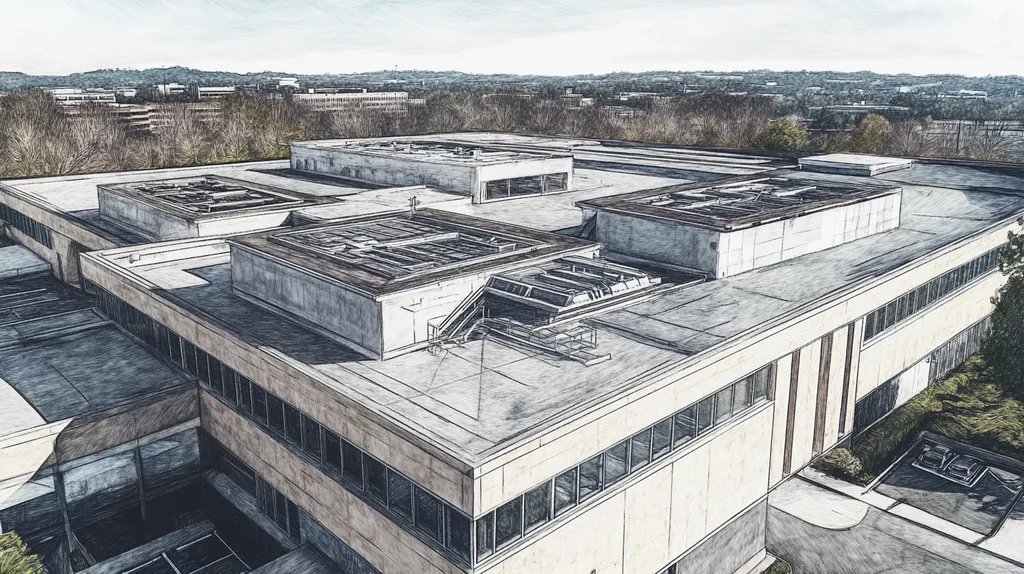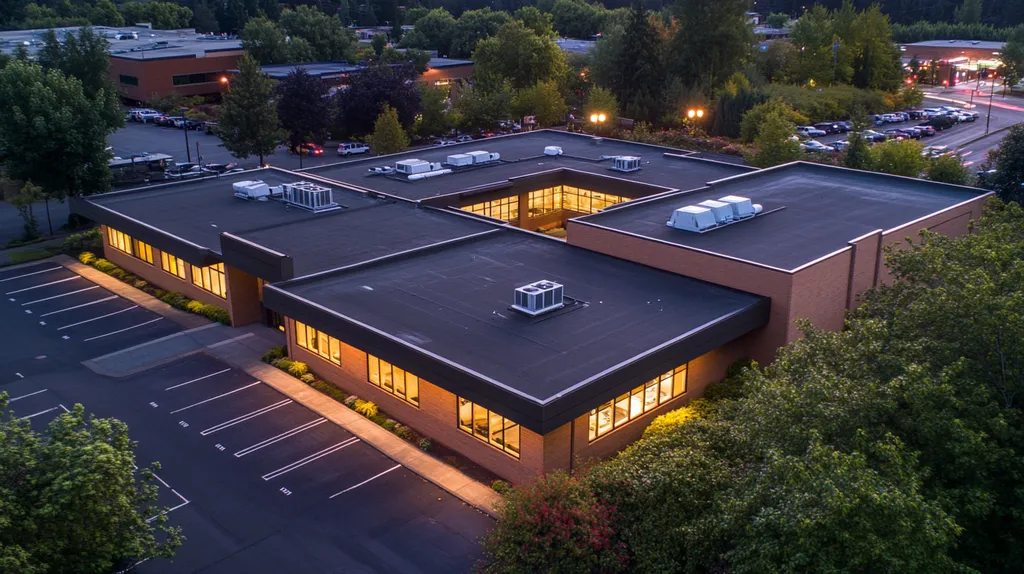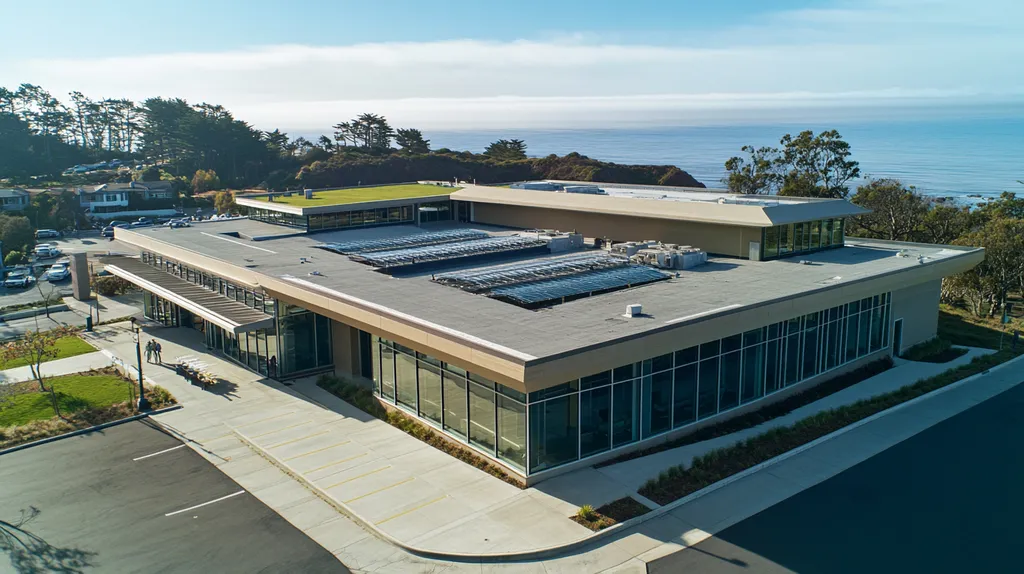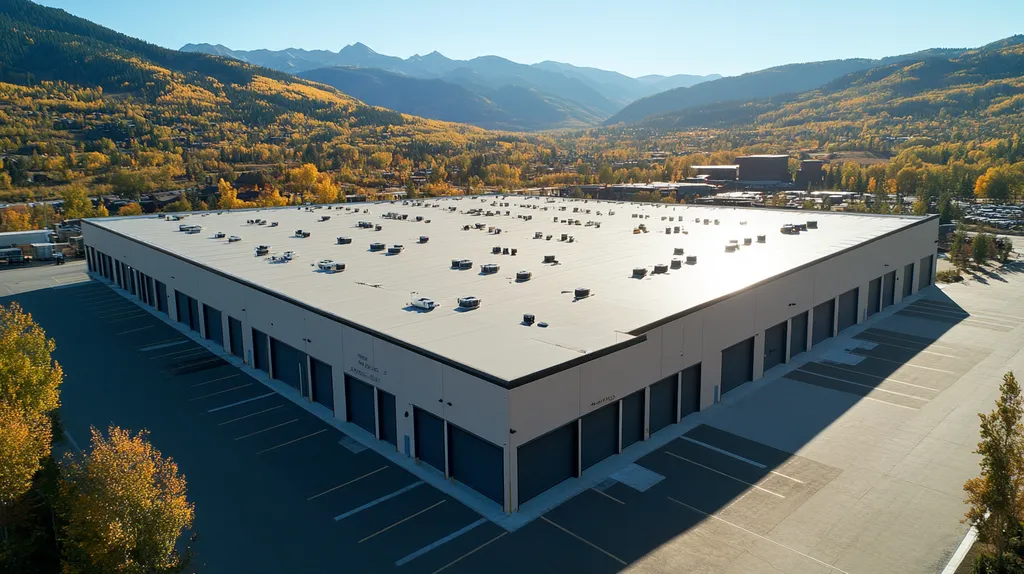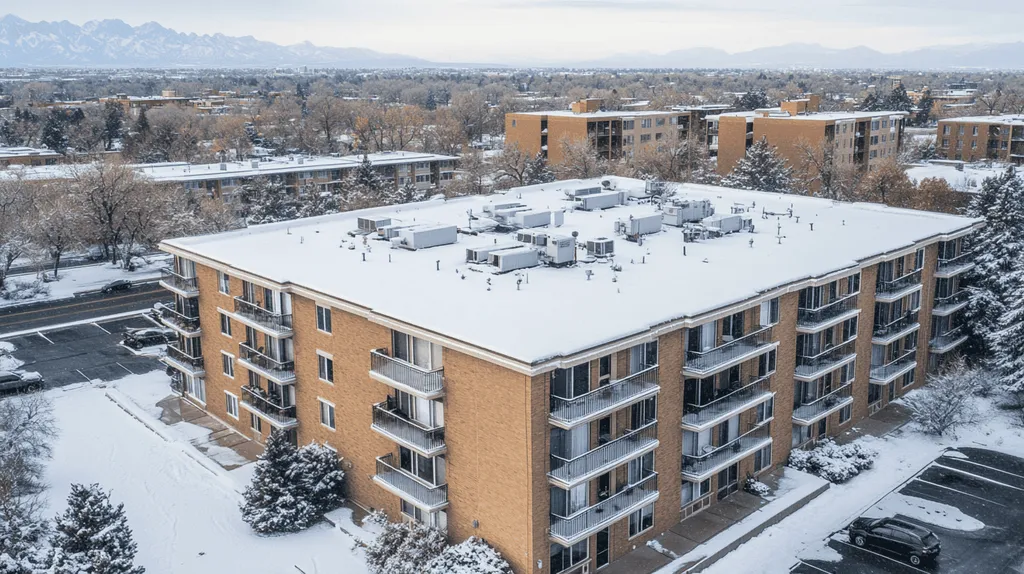In today’s commercial real estate landscape, a poorly chosen roof can drain up to 30% of a building’s annual energy budget through inefficient climate control. For property owners and facility managers, understanding how to calculate roofing savings isn’t just about numbers—it’s about protecting their bottom line.
From energy efficiency and maintenance costs to longevity and warranty considerations, the financial impact of roofing decisions ripples through every aspect of building operations.
This comprehensive guide breaks down the essential factors of roof-related savings, providing a clear roadmap for maximizing your roofing investment while avoiding costly pitfalls.
SECTION 1: THE BASICS EXPLAINED
When it comes to commercial roofing, understanding the financial repercussions can mean the difference between a well-funded future and a budgetary disaster. A wisely chosen roof can save property owners and facility managers thousands over time, making it essential to grasp how to calculate these savings. Given that commercial roofs are often a significant financial commitment, knowing how to maximize budget efficiency is paramount. This section dissects what these savings look like, why they hold importance for your building, and how the calculation process unfolds.
What It Is (In Plain Language)
Calculating savings from a commercial roof boils down to its influence on overall operational costs. This includes energy consumption, maintenance needs, and potential repair expenses. By assessing these costs, property owners can uncover how investing in a new or improved roofing system can lower monthly bills and prolong the roof’s lifespan.
For instance, energy-efficient roofing can drastically cut heating and cooling costs. By reflecting more sunlight, these roofs effectively moderate indoor temperatures, reducing dependence on HVAC systems and resulting in tangible savings over time.
A properly maintained roof also mitigates the risk of costly repairs. Taking a proactive stance is crucial, as it helps sidestep the emergency costs that often accompany neglected roofing issues.
In short, calculating savings involves examining both the immediate and long-term financial perks provided by a quality roofing system.
Why It Matters (To Your Building)
The significance of understanding savings from a commercial roof is clear: it directly impacts your building’s operational budget. At first glance, the initial investment may appear steep, but the often-overlooked savings can validate that upfront expense over time. For instance, a well-insulated roof can lead to major reductions in energy bills.
Furthermore, an intelligently selected roofing system bolsters a building’s durability. Quality roofs act as protective barriers, shielding the structure and its assets, which can ultimately help lower insurance premiums.
Tenant satisfaction is another critical consideration. Efficient roofing systems cultivate comfortable environments, which can lead to higher occupancy rates and lower turnover. This desirable outcome translates into a steadier revenue stream.
Thus, when calculating savings, property owners should not underestimate the multifaceted benefits that accrue to both their buildings and their bottom lines.
How It Works
To calculate savings effectively, the process starts with analyzing the current roofing system’s operational costs. This includes gathering data on energy usage, maintenance routines, and historical repair expenses. By consolidating this information, property owners can establish a baseline for understanding potential improvements.
Next, various roofing options should be assessed based on energy efficiency ratings and durability. Innovations in roofing materials can drastically lower operational costs. For instance, a cool roof not only minimizes thermal gain but may also make a property eligible for energy rebate programs.
It’s also critical to consider the risks associated with neglecting roof maintenance or settling for cheaper solutions. Weighing these factors against the anticipated savings from a new system empowers property owners to make decisions that align with long-term financial goals.
Ultimately, mastering the art of calculating these savings equips property owners and facility managers with the knowledge needed to make strategic roofing choices that significantly enhance their financial outlook.
SECTION 2: PRACTICAL APPLICATIONS
Calculating savings from a commercial roof isn’t just a useful exercise—it’s a necessity for savvy property owners and facility managers. Poor roofing choices can waste energy and lead to costly repairs. In fact, industry data indicates that inefficient roofs can cause commercial buildings to lose up to 30% of their heating and cooling. This section dives into practical applications, highlights the critical moments for roof upgrades, and explores how roofing systems work in harmony with other building components.
Common Uses & Examples
Commercial roofs do more than just shield buildings from the elements; they are multifunctional assets that play a pivotal role in energy efficiency and cost management. For example, well-insulated roofs can trim HVAC costs by as much as 20% per year, providing a compelling return on investment.
Reflective roofing options are another smart choice, as they significantly reduce heat absorption, thereby lowering cooling expenses. Facilities with flat roofs often reap the benefits of green roofing systems, which not only offer additional insulation but also aid in stormwater management, leading to even greater savings.
Investing in energy-efficient materials can lead to utility rebates and reduced energy bills, amplifying your return on investment. Upgrading to a more durable roof doesn’t just streamline maintenance costs; it frees up resources that can be redirected to enhance other critical areas of the business.
Ultimately, making informed roofing choices enhances the structural integrity of a property and boosts tenant satisfaction. A well-maintained roof can draw in high-quality tenants, resulting in increased rental income and improved cash flow.
When You Need It Most
Timing is everything when it comes to addressing roofing needs. Seasonal fluctuations can reveal weaknesses, creating urgent situations that require immediate attention. For instance, the onset of winter may expose leaks or insulation failures that were previously hiding in plain sight.
Property owners should also remain vigilant during significant weather events, such as heavy rain or storms, which can highlight existing issues and lead to expensive repair bills if not handled promptly. Regular inspections before and after adverse conditions can save money and prevent long-term damage.
Annual budget cycles frequently dictate when upgrades can occur. Incorporating roofing evaluations into financial planning is essential, as delaying action until problems surface can lead to higher costs associated with emergency repairs compared to planned upgrades.
A proactive approach allows property owners to assess roofing conditions, plan necessary upgrades, and explore financing options, making the roofing process smoother and more efficient. Addressing needs in a timely manner enhances the potential for significant long-term savings.
Interactions With Other Systems
Roofs don’t operate in isolation; their performance is closely linked to other building systems like HVAC and insulation. A roof lacking proper insulation can undermine climate control efficiency, putting extra strain on HVAC systems and increasing energy costs across the board.
Effective coordination among contractors during roofing projects can yield substantial operational savings. For instance, coupling a new roof with energy-efficient HVAC upgrades can optimize performance, drastically enhancing overall energy efficiency.
Flashing and drainage systems are also critical for maintaining roof longevity. Improperly installed flashing or a drainage system that doesn’t function correctly can lead to leaks and standing water, issues that can damage roofing materials and void warranties.
In conclusion, recognizing the interplay between roofing systems and other building components is vital for maximizing savings. Property owners should always consider roofing decisions within a larger strategy aimed at boosting building performance, minimizing costs, and keeping tenants happy.
SECTION 3: KEY TERMINOLOGY DECODED
Navigating the world of roofing terminology can feel like wandering through a dense fog—confusing and uncertain. Misunderstandings in this arena can lead to costly blunders that reverberate through budgets and maintenance plans. This section aims to clear up that fog by breaking down essential terms, simplifying measurement units, and translating industry language into practical insights that empower informed decision-making.
Essential Terms Explained
Understanding the “roofing lifecycle” is like having a roadmap to financial planning. This term describes the span from when a roof is installed to when it must be replaced. Knowing this helps property owners budget not just for installation, but for future expenditures, aiding in long-term financial forecasting.
The “R-value” is a crucial indicator of a roof’s thermal resistance. A higher R-value signifies better insulation, which translates to lower energy costs. This is particularly critical in regions with extreme temperatures, where heating and cooling demands can inflate operational budgets.
“Sustainability” is an important buzzword in today’s construction landscape, highlighting roofing systems designed with environmental awareness. Green roofs not only contribute to lower energy bills but can also earn LEED certifications, attracting eco-minded tenants and clientele.
Familiarity with these terms arms property owners with the knowledge to engage more effectively with professionals, steering decisions that optimize both performance and finances.
Industry Jargon Translated
To some, the language of roofing can seem like a foreign tongue, but understanding key jargon can sharpen communication. For example, “decking” refers to the underlying surface of a roof, often crafted from wood, metal, or concrete. This knowledge aids in selecting options that align durability with budget constraints.
Familiarity with materials like “TPO” (Thermoplastic Olefin) and “EPDM” (Ethylene Propylene Diene Monomer) empowers property owners to analyze choices based on costs, efficiency, and longevity. Understanding these acronyms leads to a well-rounded decision-making process.
Grasping this industry jargon transforms potential misunderstandings into informed discussions that align contractor visions with property owners’ goals.
Measurement & Units Simplified
Roofing measurements can often feel like a complex puzzle, but breaking them down makes the process manageable. The term “square” represents 100 square feet of roofing area, a handy unit for estimating materials and labor costs, ensuring budgets are on point.
The “pitch” is another key measurement that indicates how steep a roof is. This factor significantly influences water drainage and informs choices about the types of roofing materials that best suit specific needs.
“MIL” indicates the thickness of roofing membranes. Knowing the appropriate thickness can enhance a roof’s durability and performance while saving money on future maintenance and replacements.
Simplifying these measurements equips property owners with the confidence to interpret quotes and make decisions that resonate with their financial strategies, ultimately leading to smarter roofing solutions.
SECTION 4: DECISION FACTORS
Choosing the right roofing system for a commercial property is a monumental task—make a misstep, and the financial consequences can be catastrophic. A subpar installation can lead to leaks, costly interior repairs, and bloated energy bills. Property owners and facility managers must evaluate several critical factors, including cost, performance, and durability, to ensure their roofing system remains efficient and effective for years to come.
Cost Considerations
Cost looms large in roofing decisions, tempting property owners to grasp the lowest initial bid like a lifeline. However, chasing after that bargain can backfire spectacularly. Consider this: a cheap roofing material may require an early replacement, ultimately hiking up the cost more than opting for a higher-quality option from the get-go.
Investing a bit more upfront in a durable roof can translate into substantial savings over its lifecycle. While high-quality materials might seem pricy at first, they typically result in lower repair and maintenance expenses down the line. Plus, energy-efficient roofs can substantially slash utility bills, enhancing overall cost effectiveness.
Additionally, many states offer incentives or rebates for energy-efficient roofing solutions, which can significantly reduce initial costs. Carefully considering both the upfront expense and total ownership costs is essential for any smart roofing decision.
In summary, while keeping to a budget is necessary, compromising on quality could lead to greater expenses as time marches on. To avoid such a pitfall, property owners should evaluate all financial factors before deciding on roofing solutions.
Performance Trade-offs
Performance trade-offs are essential to weigh when selecting a roofing system, as a roof’s effectiveness directly impacts operational efficiency and tenant comfort. Different materials boast varying degrees of thermal performance, affecting heating and cooling costs as the seasons change.
For instance, reflective roof membranes can significantly lower heat absorption, which translates to energy savings. However, they might not perform as well in heavy rain or snow. Understanding your local climate and how roofing materials respond to it is crucial for long-term satisfaction.
Some materials might also require more frequent maintenance, adding costs and inconveniences that can quickly escalate. Owners must ponder their willingness to dedicate time and financial resources to maintenance versus the reliability offered by more resilient roof options.
Ultimately, finding the right balance between performance characteristics and operational requirements can yield significant benefits. A well-informed choice can elevate building performance while streamlining costs.
Lifespan & Durability Factors
Lifespan and durability play leading roles in the selection of a roofing solution. The longevity of a roof has direct financial implications; the longer it lasts, the fewer replacements and repairs property owners will have to budget for. For instance, metal roofs can serve up to 50 years, while asphalt shingles may only enjoy a 20-year lifespan.
Durability is equally important, especially in regions facing harsh weather conditions. Investing in roofs designed to withstand extreme winds or heavy precipitation will prove invaluable over time, saving both money and headaches.
Additionally, warranties from roof manufacturers can indicate durability. A solid warranty reflects manufacturers’ confidence in their products. Property owners should take the time to understand what coverage includes and how it aligns with their needs.
As property managers assess lifespan and durability, they must consider the initial investment alongside long-term budget impacts. A resilient, long-lasting roof can stand as one of the best investments any property owner can make.
SECTION 5: COMMON CHALLENGES
Navigating the world of commercial roofing can feel a bit like tiptoeing through a minefield; one wrong step and the consequences can be costly. Statistics reveal that roof failures can spur exorbitant repair costs and lost revenue, emphasizing the importance of awareness for property owners and facility managers. By identifying frequent issues, recognizing warning signs, and employing effective preventative strategies, they can extend roof life and shield their investments from unexpected disasters.
Frequent Problems & Solutions
Common roofing headaches include leaks, punctures, and drainage woes, often caused by the relentless elements and the wear that comes with time. Take a flat roof with poor drainage; it can turn into a mini swimming pool during a rainstorm, triggering leaks and compromising structural integrity.
One of the most effective remedies? Regular inspections. A keen eye can spot potential issues before they balloon into bigger problems. Plus, keeping gutters clean and attending to minor repairs can significantly enhance a roof’s lifespan.
Material degradation is another sneaky culprit. Over the years, components can weaken from UV exposure, temperature swings, and moisture. Investing in high-quality roofing materials suited to the local climate can go a long way in combating this issue.
Equally important is the installation phase; if corners are cut during this critical step, roofing failures can become a harsh reality. Hiring reputable contractors with proven success records is essential for securing a roof that thrives.
Warning Signs To Watch For
Sometimes, roofing problems wear a cloak of subtlety, making them easy to overlook but crucial to notice early. One classic red flag is discoloration or water stains on ceiling tiles—a telltale sign that there could be leaks lurking above.
Another telltale sign is sagging or uneven areas on the roof, which might indicate structural issues stemming from inadequate drainage or accumulated moisture. Regularly monitoring these spots can help nip potential problems in the bud.
Property owners should also keep an eye on granule loss from shingle roofs. Missing granules can significantly shorten a roof’s lifespan, increasing vulnerability to adverse weather conditions.
Finally, rising energy bills can signal trouble. If a roof isn’t properly insulating the building, heating and cooling costs may spike. Being vigilant about these expenses can offer valuable insights into the health of the roof.
Preventative Approaches
Taking a proactive stance is paramount for effective roof maintenance. Establishing a regular upkeep schedule is a smart strategy, encompassing thorough inspections and routine cleaning to clear away debris and ensure proper drainage.
Investing in a high-quality roof coating can provide an additional layer of protection, shielding against UV rays and moisture, thereby extending the roof’s lifespan.
Education plays a pivotal role for property owners and facility managers. A deep understanding of their roof’s specific needs can help prevent missteps that could lead to costly repairs. Awareness of common challenges empowers them to act effectively.
Finally, fostering a relationship with a trusted roofing contractor can streamline maintenance efforts. Contractors offer invaluable insights and timely recommendations, fortifying long-term roof performance.
SECTION 6: NEXT STEPS & RESOURCES
For property owners and facility managers, the stakes in commercial roofing are incredibly high. Investing inadequately now can lead to costly repairs and energy inefficiencies down the line. A poorly insulated roof can sap up to 30% of energy costs annually. By knowing the right questions to ask and leveraging the best resources, one can drastically improve roofing outcomes, paving the way for immediate and long-lasting savings.
Questions To Ask Providers
When it comes to evaluating roofing providers, asking the right questions is key. Begin by inquiring about their experience with similar projects; familiarity can greatly influence overall performance and reliability.
Next, dig into materials and warranties. Understanding the lifespan and resistance of materials to environmental challenges can make a significant difference in your roof’s longevity.
It’s wise to inquire about the provider’s safety record as well. Prioritizing safety during roof installation not only protects workers but also shields property owners from potential liabilities.
Lastly, discuss the availability of ongoing maintenance options. A solid maintenance plan is essential for sustaining the roof’s health and effectiveness, thus safeguarding your initial investment.
Industry Standards & Guidelines
Familiarity with industry standards is imperative for any roofing project. Organizations like the National Roofing Contractors Association (NRCA) and the American Society for Testing and Materials (ASTM) provide critical guidelines that can serve as benchmarks for quality.
These guidelines encompass best practices for installation, materials, and safety protocols. By adhering to them, you can minimize risks while enhancing your roofing system’s durability.
The Energy Star program is another invaluable resource, identifying energy-efficient roofing products designed to significantly reduce energy costs.
Consulting these documents empowers property owners to make informed decisions, ensuring compliance with industry expectations and maximizing their savings.
Further Learning Simplified
Continuous education is essential in a rapidly evolving industry. A plethora of online platforms now offer webinars and courses focusing on commercial roofing, covering topics from foundational knowledge to the latest innovations.
Additionally, subscribing to industry magazines and journals can keep property owners informed of trends and technologies that could affect their investments.
Networking with peers at industry conferences provides practical insights, enabling property owners to share experiences and refine their roofing management strategies.
By dedicating time to these learning opportunities, property owners acquire the knowledge necessary for making informed decisions that will translate into significant long-term savings.
The Bottom Line
With commercial roofing costs rising 15-20% annually, property owners can’t afford to overlook the potential savings a well-planned roofing strategy delivers.
From energy efficiency gains of up to 30% to extended lifespans that can stretch beyond 50 years, the financial impact of informed roofing decisions reverberates throughout a building’s operational lifetime.
By leveraging industry standards, maintaining preventative maintenance schedules, and partnering with qualified contractors, facility managers can transform their roofs from cost centers into valuable assets.
The path to maximizing roofing savings requires vigilance, expertise, and strategic planning – but the rewards of reduced operating costs, enhanced tenant satisfaction, and improved property values make it an investment worth every careful consideration.
FREQUENTLY ASKED QUESTIONS
Q. What is the importance of calculating savings from a commercial roof?
A. Understanding savings is crucial as it directly impacts financial decisions. A well-chosen roof not only reduces energy bills but also enhances durability, mitigating future repair costs. This strategic approach protects the building’s budget and ensures longevity.
Q. How do I apply practical savings measures for my industrial roof?
A. Assessing energy efficiency is key. Implementing reflective or insulated roofing options can notably decrease heating and cooling costs. Additionally, timing upgrades with budgeting cycles allows for planned maintenance that avoids unexpected expenses.
Q. What key terms should I know about my commercial roof?
A. Familiarize yourself with terms like “R-value,” indicating insulation effectiveness, and “decking,” the roof’s structural layer. Understanding these terms is essential for making informed choices that align with your budget and energy efficiency goals.
Q. What decision factors should I consider for a commercial roof?
A. Consider the costs, materials’ lifespan, and environmental performance. Higher-quality roofs may have a steeper initial price but often lead to lower maintenance and energy expenses over time, thus providing better long-term savings.
Q. What frequent challenges might I encounter with an industrial roof?
A. Common issues include leaks, punctures, and improper drainage. Regular inspections can help identify problems before they escalate, while timely maintenance further extends roof life and protects your investment from significant costs.
Q. What next steps should I take for my commercial roof?
A. After understanding your roof’s needs, ask contractors about their experience, materials used, and maintenance plans. Familiarizing yourself with industry standards will help ensure you’re making informed decisions that will result in long-term benefits.
Q. How can technology improve savings on my commercial roof?
A. Leveraging technology like roofing management software allows for efficient tracking of maintenance and performance metrics. Additionally, smart roof systems can optimize energy use and maintenance scheduling, ultimately leading to substantial cost reductions over time.

